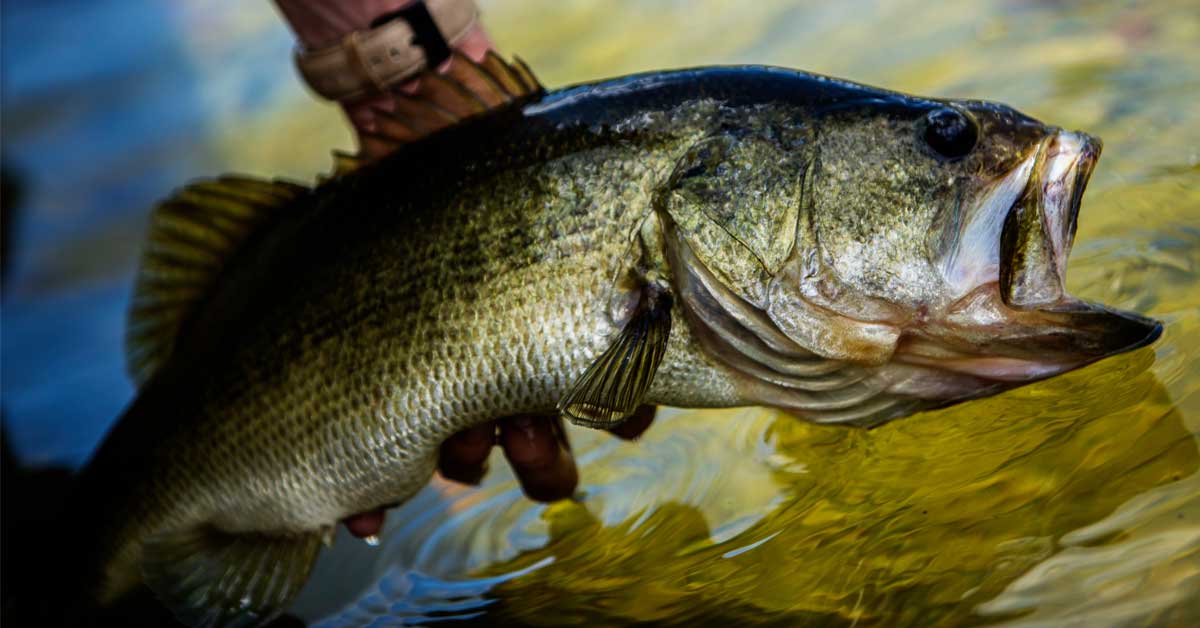
Photo: Shutterstock.
By Dr. Peter Brookes
Pssssst! Here’s a dirty little secret for you: If you want to catch your biggest largemouth bass of the year, this month—March—may be your best bet to net “basszilla.”
That may sound a bit odd, but, according to John Odenkirk, Virginia Department of Wildlife Resources (DWR) biologist, a lot of very big largemouth bass are caught this time of year as Mother Nature moves us from winter to spring.
As water temperatures increase, largemouth bass will shake off the cold and become increasingly active. In the pre-spawn, they’ll fatten up; while spawning, largemouth bass will become more aggressive, protecting against threats to their eggs.

Lake Anna is considered one of the top large mouth bass fisheries in Virginia. Photo by Meghan Marchetti/DWR.
As Virginians, we’re really blessed with some incredible largemouth bass fisheries right here in the state. Indeed, anglers are known to travel big distances from across our great land to throw a lure at an Old Dominion “lunker.”
If you didn’t already know from the number of largemouth bass fishing tournaments that take place there, Lake Anna is considered one of the top “bucketmouth” fisheries in Virginia.
One of the largest reservoirs in the state, Lake Anna is easily reachable from Northern Virginia, Fredericksburg, Richmond and Charlottesville. You just can’t argue with that sort of accessibility—or fishing.
And then, of course, there’s the powerful and plentiful Potomac River. It turns out that our beloved Potomac and its tidal creeks aren’t only an incredible fish factory, but one of the—if not the—top largemouth bass fisheries in the United States.
Nice.
The other awesome thing about these two water systems is that, as Odenkirk wisely pointed out to me, if the Potomac River is looking unfishable, Lake Anna may well be totally fishable or at least fishable in spots.
That means if we have a really rainy year like last year—which, I understand, was one for the record books—when the Potomac River is high and off-color, it’s likely, that as a reservoir, most parts of Lake Anna could be eagerly awaiting your fly, lure or bait.
The mid-lake region along Rose Valley, Ware Creek and the State Park along the outside edge of water willow beds can produce outstanding spring angling, Odenkirk told me.
In other words, while we all need to heed Mother Nature (e.g., thunderstorms, high water, etc.), there may be no good excuse for leaving your bass tackle box and rods at the back of the gear closet if the weather has been on the wet side.

Photo: Shutterstock.
Of course, these fabulous fish are available in Virginia beyond the Potomac River and Lake Anna—don’t get me wrong.
DWR notes that Gaston, Buggs Island, Chickahominy, Chesdin, Smith Mountain, Prince, Briery Creek, Western Branch and Flannagan Lakes are all top-notch largemouth fisheries. For rivers, hit the Chickahominy (below Walkers Dam) and James (below the fall line).
Of course, bass can be caught using fly or spin tackle.
According to DWR, plastic worms and other plastic imitations, crankbaits, spinner baits, surface lures, jigs and other artificials, imitating minnows, crayfish, frogs, salamanders and nightcrawlers are good bets for the spin rodder.
Live bait options recommended by DWR include jumbo shiners, small bluegills, minnows, crayfish, nightcrawlers and frogs. For the fly guys and gals, streamers and large poppers on the end of an 8-pound to 10-pound leader can be productive.
Nothing quite like the thrill of seeing a largemouth slam an artificial on the surface.
In terms of where to find largemouths this time of year, target horizontal and vertical structure (e.g., down wood and docks) and southern exposed flats near drop-offs late in the afternoon to bag these early season bass.
With an average weight of 2 – 4 pounds—with monsters tipping the scales at up to 10 pounds—there’s no question that the hard-fighting Micropterus salmoides is arguably America’s greatest freshwater game fish.
And, even better, this month would be an opportune time to bring a Virginia “bassquatch” to hand.
Buy Your LicenseDr. Peter Brookes is a DC foreign policy geek by day and a Virginia outdoor scribbler by night. [email protected]


